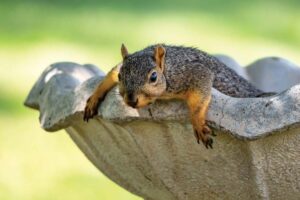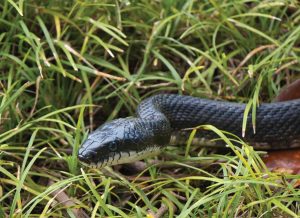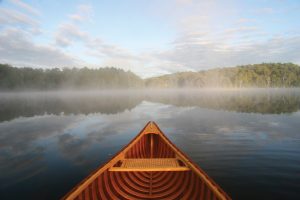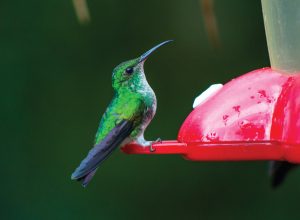‘Tis the season for the return of hummingbirds. These tiny birds migrate from their winter homes of Central America and southern Mexico in April and May and will return south again in September. Hummingbirds are creatures of habit and often return to the same feeder within days of when they did in previous years.
There are many sizes and styles of hummingbird feeders on the market. Some might be more appealing to the birds than others. Through trial and error, you will find what the birds prefer. One thing you will notice with all the feeders is they are often red in color. Hummingbirds have heightened sensitivity to the yellow and red end of the color spectrum, with blues appearing duller to them. Therefore, the bright, warm colors stand out more.
In order to enjoy the sight of hummingbirds, you must have the proper food the birds need to survive. The nectar recipe I use is one-part ordinary white cane granulated sugar and four parts water. The addition of red coloring is not advised as it can be harmful to the birds.
Tap water is fine to use; it is not necessary to boil the water. A common myth is that boiling will reduce fermentation, but fermentation is not caused by anything in the water. Boiling will reduce the levels of chlorination and fluoridation if you are using a system in which these are present. Sugar does dissolve better in warm water, but even that is not required if care is taken to stir until all the sugar is dissolved. You can prepare more nectar than your feeder will hold. It will safely store in the refrigerator for up to three weeks.
This mixture is about the same sweetness as natural nectar and will not attract nearly as many insects as a syrupier mixture. The 1:4 mix has been proven to be harmless and will provide the needed energy. Commercial hummingbird food is also not necessary and may be undesirable. It is also certainly more expensive and inconvenient than readily available home ingredients of water and sugar.
Hummingbirds are not naturally drawn to feeders. By watching other hummingbirds and by their natural curiosity, they eventually find the feeders. You can aid their ability to find the feeders by hanging a red ribbon near it.
If you have ever watched hummingbirds, you know they are very territorial, especially the male hummingbirds that like to chase off other birds. It might be necessary to put a second feeder to allow the other birds the opportunity to eat. When choosing where to hang a feeder for the first time, you need to know that just any old place will not produce good results. New feeders are best hung near a flower garden, flower pot or window box as that is one of the first places a hummingbird will check for food.
Besides having plenty of feeders for the birds, there are a few other things you can do that will help keep birds on your property all summer long.
Like many birds, hummingbirds love to bathe. Add a mister attachment to your hose so they have access to a regular water supply. Hummingbirds can’t seem to resist fine, moving water. They will love flying through it to soak their feathers before heading off to preen.
Even though you may not be a fan of spider webs and other insects, hummingbirds are. Besides nectar, hummingbirds also rely on the protein that comes with insects. Choose flowers that are attractive to insects so hummingbirds have plenty of food to suit all their needs.
Spider webs serve two purposes for hummingbirds. First, they are one of the common features of hummingbird nests. They use the webs to hold their nests together for sturdiness. The webs are also a great source of protein-rich insects for hummingbirds.
Hummingbirds are here just a few months out of the year. Be ready when they begin to arrive and take the necessary measures needed to enjoy these tiny birds all summer long.
Photo courtesy of Sandra Cooper








